What Are Layer 1 and Layer 2 Coins? A Simple Breakdown
Confused about Layer 1 and Layer 2 in crypto? This simple guide breaks down what they are, how they differ, and why it matters for traders in Nigeria, Ghana, and Cameroon.
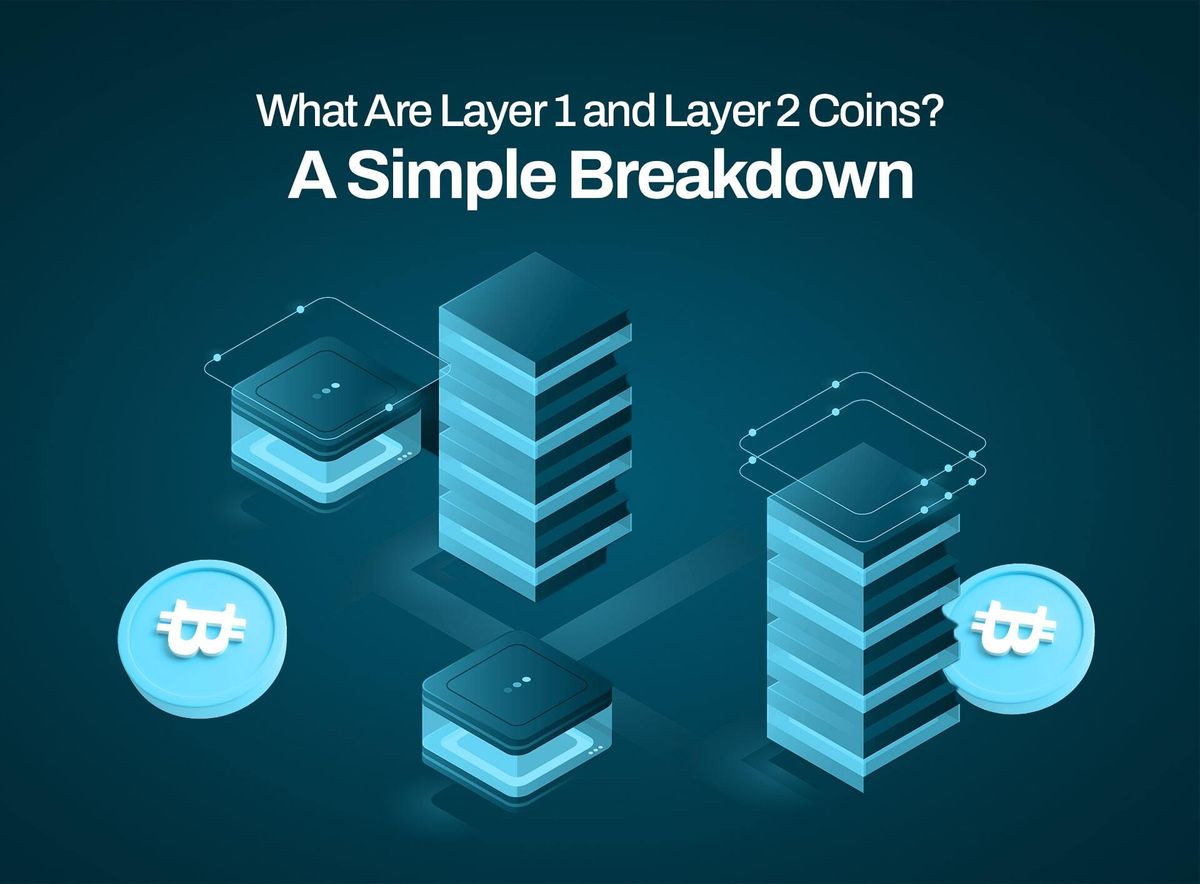
Table of Contents
- What is a Layer 1 Coin?
- What is a Layer 2 Coin?
- Key Differences Between Layer 1 and Layer 2
- Why It Matters for Traders in Africa
- How to Trade Layer 1 and 2 Coins on Obiex
- To Recap
- FAQs
If you’ve ever wondered why some coins move faster or cost less to trade, the answer usually comes down to whether they’re built on Layer 1 or Layer 2.
These layers affect everything from speed to fees to the network's flexibility.
Let’s break it down.
What Is a Layer 1 Coin?
A Layer 1 coin is the main cryptocurrency that powers a base blockchain, meaning it is the original network where everything happens, including transaction processing, security, and network rules.
Simply put, Layer 1 blockchains, such as Bitcoin, Ethereum, Solana, or Cardano, are the “main roads” of crypto.
These networks don’t rely on any other blockchain to function. They operate independently and have their own native coins, like BTC for Bitcoin, ETH for Ethereum, SOL for Solana, and ADA for Cardano.
What Does Layer 1 Do?
- Handles security: Layer 1 networks protect themselves using protocols like Proof of Work (e.g., Bitcoin) or Proof of Stake (e.g., Ethereum 2.0 and Cardano). These systems prevent fraud and keep the network safe.
- Validates and confirms transactions: Every crypto transaction, sending coins, using a dApp, or making a swap, is confirmed by the Layer 1 network.
- Maintains decentralisation: Anyone can join the network and help verify transactions. Thousands of nodes (computers) around the world work together. No single person or company is in charge.
- Supports smart contracts and dApps: Platforms like Ethereum and Solana allow developers to build decentralised apps (dApps) and smart contracts directly on their Layer 1 blockchain.
Popular Layer 1 Coins:
Here are some of the most widely used and important Layer 1 coins in crypto:
- Bitcoin (BTC) – The first and most secure Layer 1. It doesn’t support smart contracts, but it’s trusted as “digital gold” and has the largest market cap.
- Ethereum (ETH) – The most popular Layer 1 for building DeFi apps, NFTs, and smart contracts. Many other networks and tokens rely on Ethereum as their base layer.
- Solana (SOL) – Known for being extremely fast (65,000+ transactions per second) with very low fees. It’s great for gaming, NFTs, and scalable DeFi.
- Cardano (ADA) – Designed with a focus on academic research and sustainability. It’s a proof-of-stake blockchain that supports smart contracts and is being used in real-world projects in Africa and beyond.
Pros of Layer 1 Coins:
- Highly secure: Since they use advanced cryptography and consensus mechanisms, it’s very difficult to hack or shut them down. Bitcoin, for example, has never been successfully hacked.
- Truly decentralised: These networks don’t have a central authority. Instead, users around the world contribute to running and securing them, which increases trust.
- Widely adopted: Most crypto wallets, exchanges (like Obiex), and DeFi tools support Layer 1 coins. They are the starting point for many crypto investors and developers.
Cons of Layer 1 Coins:
- Slow transaction speeds: For example, Bitcoin can only handle around 7 transactions per second, which is much slower than traditional payment systems like Visa.
- High fees: When many people use a Layer 1 like Ethereum, fees (known as gas fees) can spike. It’s not unusual to pay $10–$50 or more to make a single transaction during busy times.
- Scalability issues: As more people join the network, it can get congested. This leads to delays and higher fees. That’s why Layer 2 solutions (like Arbitrum and Polygon) were created to help fix these problems.
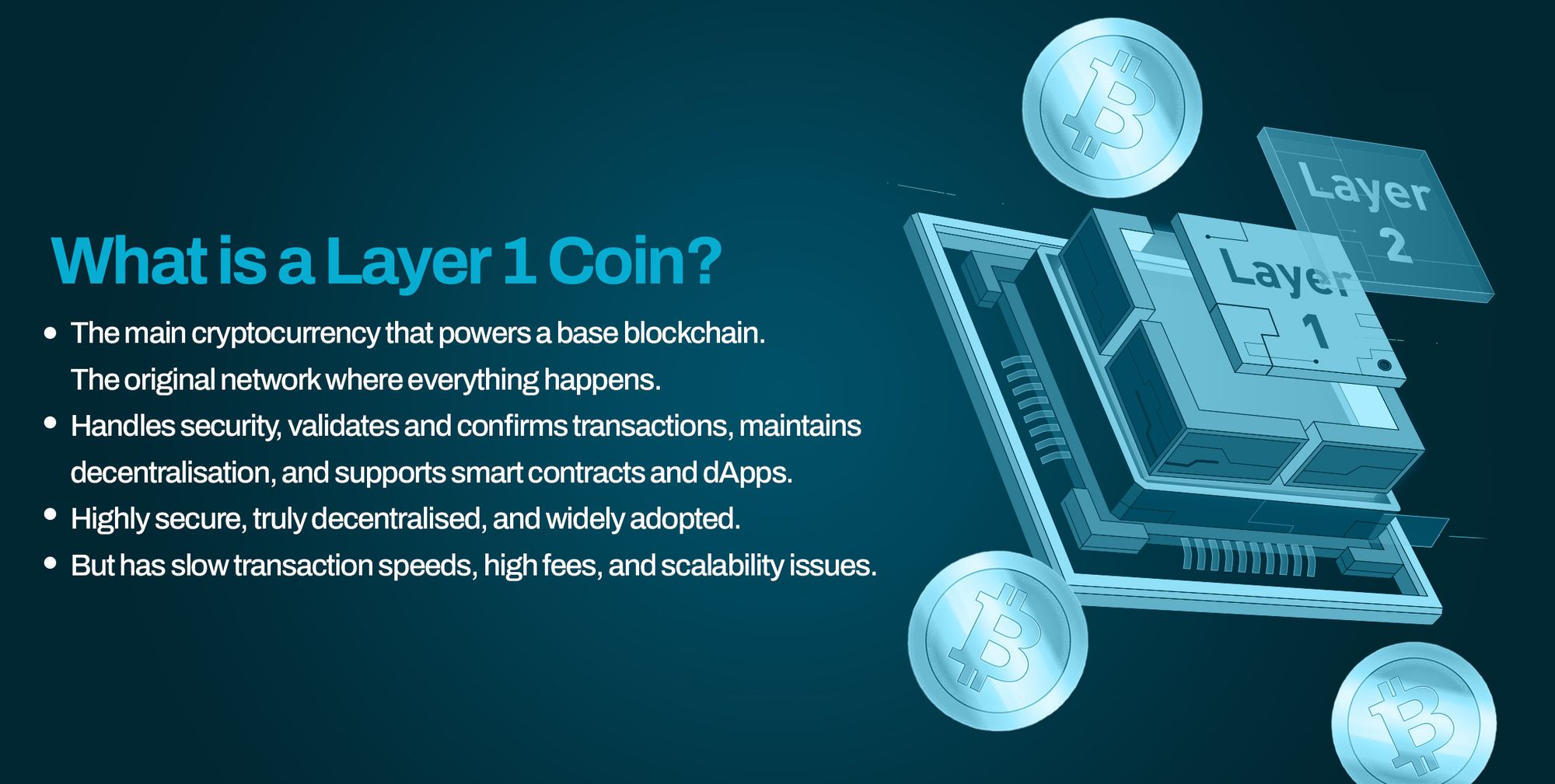
What Is a Layer 2 Coin?
Layer 2 coins are built on top of the Layer 1 network.
While Layer 1 handles all core activity (such as Ethereum and Bitcoin processing transactions directly on-chain), Layer 2 coins help alleviate pressure by moving most of the action off the main network.
This is where the concept of “Layer 2” becomes clear: Layer 2 coins support systems that process transactions off the main chain, bundle them together, and then send a summary back to Layer 1 for final confirmation.
This setup enables transactions to be processed much faster and more cost-effectively, without compromising the security provided by the underlying blockchain.
What Does Layer 2 Do? Layer 2 networks:
- Process transactions off-chain, meaning outside the main blockchain network.
- Bundle multiple transactions together and send them in batches to Layer 1.
- Still rely on Layer 1’s security features to stay safe and tamper-proof.
Popular Layer 2 Coins:
- Polygon (MATIC): Built on Ethereum. It helps reduce fees and increase transaction speed.
- Arbitrum (ARB): Another Ethereum Layer 2 that uses rollup technology to boost performance.
- Optimism (OP): A fast-growing Layer 2 for Ethereum that also uses rollups.
- Lightning Network: Built on Bitcoin, designed for fast and cheap microtransactions.
Pros of Layer 2 Coins:
- Much lower fees: Some transactions cost as little as $0.001.
- Faster transaction speeds: Polygon handles about 65,000 transactions per second, compared to Ethereum’s average of 15–30.
- Great for crypto payments, DeFi, and trading, especially when speed and affordability are key considerations.
Cons of Layer 2 Coins:
- Slightly more complex for new users to understand or use.
- Some are less decentralised, relying on central operators or validators.
- They depend on Layer 1 to operate, so if Layer 1 has issues, Layer 2 may also be affected.
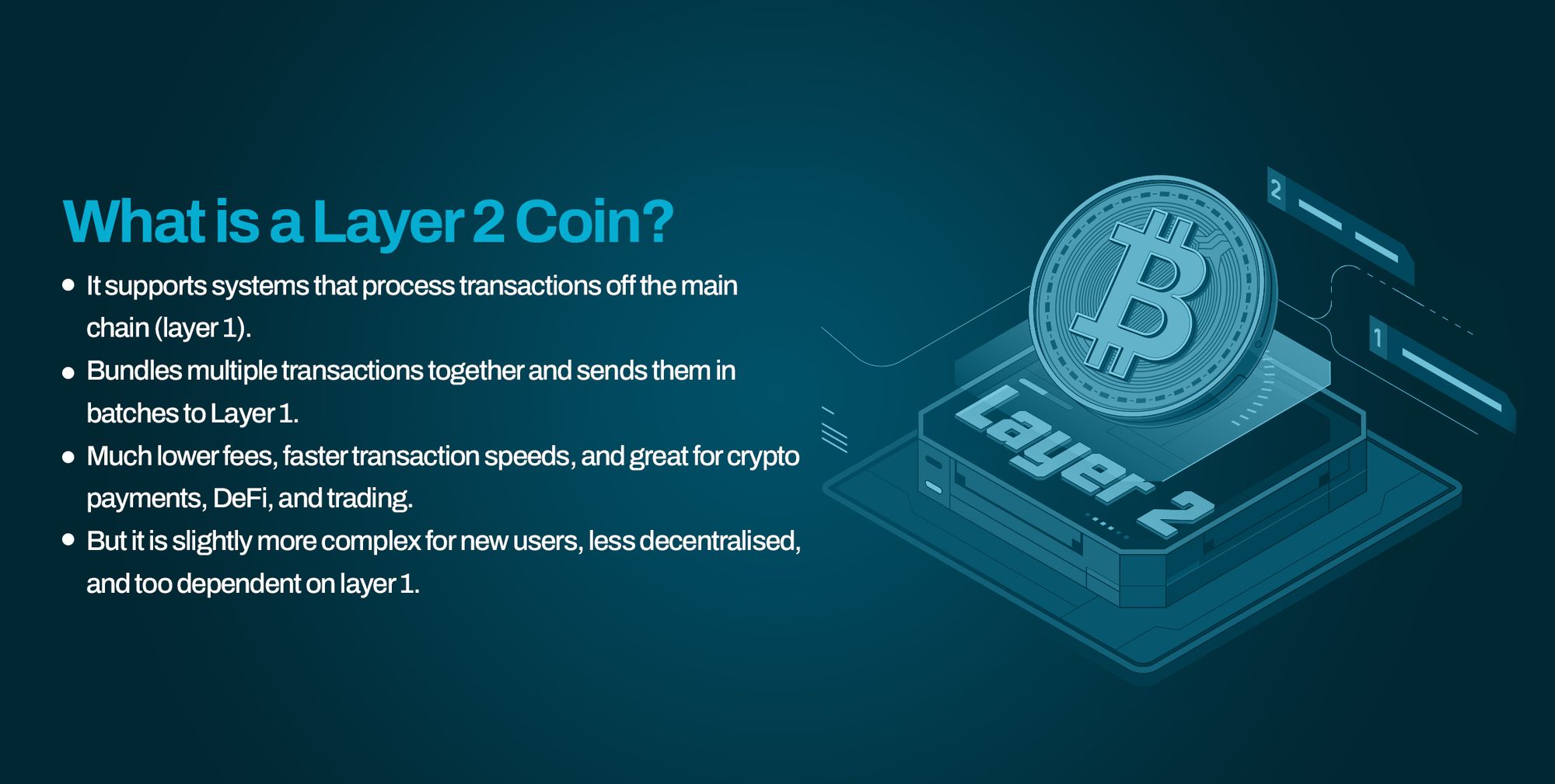
Key Differences Between Layer 1 and Layer 2
Why It Matters for Traders in Africa
1. Lower Fees Mean Bigger Gains:
Layer 1 networks often suffer from high transaction fees. For African traders whose average monthly incomes are significantly lower than in Western markets, paying $10 to send $50 is not sustainable.
Layer 2 coins help reduce these fees by processing transactions off the main blockchain and then syncing the results back.
2. Faster Transactions Help You Trade on Time:
Timing is everything in crypto. Delays caused by congested Layer 1 networks can result in traders missing thousands of dollars in opportunities.
Bitcoin transactions, for instance, can take 10 minutes to confirm, whereas a Layer 2 solution like Arbitrum can complete a trade in under a minute.
With diverse options, you can trade Layer 1 coins and quickly move to Layer 2 tokens like MATIC or ARB to take advantage of market trends.
3. Better Flexibility for Cross-Border Payments:
Many African traders use crypto not just for trading, but also for sending and receiving payments across borders.
If you're sending USDT from Nigeria to South Africa, using a Layer 2 solution could reduce your transaction time from 10 minutes to just 30 seconds and cut fees by over 90%. That’s powerful utility, especially for users managing multiple transactions daily.
4. More Options = Better Risk Management:
Diversifying between Layer 1 and Layer 2 coins enables African traders to strike a balance between security and speed.
While Layer 1s offer strong network security, Layer 2s offer agile and cost-efficient alternatives for more frequent trades.
Traders can utilise platforms that enable them to hold both types of assets and swap instantly, providing them with better control over their trading strategy.
5. Real-World Use Cases Are Growing in Africa:
From buying airtime with USDT to paying school fees in Bitcoin, African crypto adoption is growing fast.
However, adoption only makes sense when it’s both affordable and efficient. Both Layer 1 and Layer 2 play key roles in this regard.
Understanding Layer 1 and Layer 2 crypto helps African traders select the right network for specific tasks, whether high-value storage or day-to-day spending, so they don’t waste money or time.
6. Obiex Makes It Easy to Switch Between Layers:
Finally, all this knowledge would be useless without a platform that supports smooth movement between layers.
On Obiex, you can buy ETH, BTC, MATIC, trade Layer 2 tokens, and swap from Layer 1 to Layer 2 without needing to manually bridge assets or pay extra swap fees.
This saves time, reduces complexity, and ensures African traders can take full advantage of both layers of the crypto ecosystem without friction.
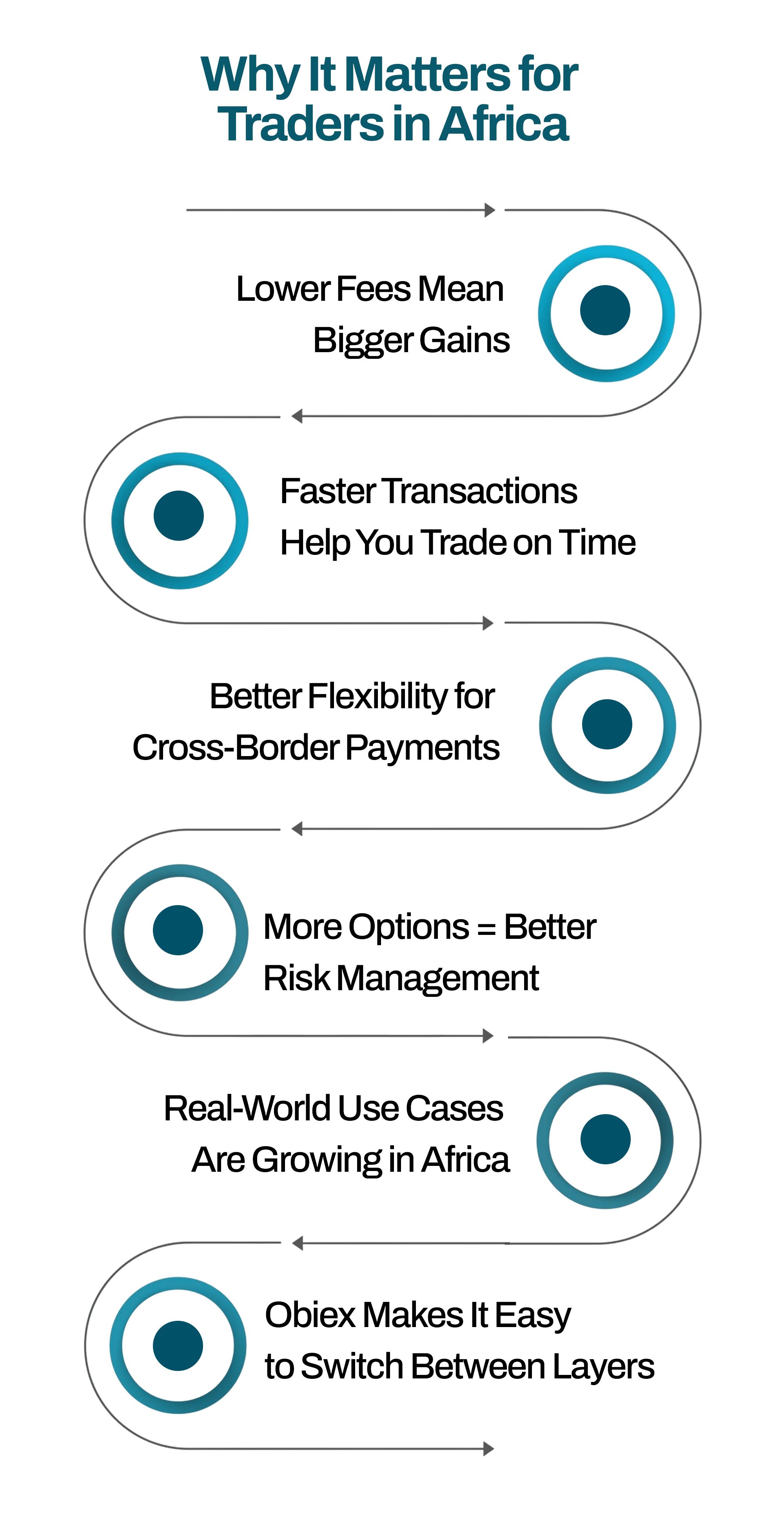
How to Trade Layer 1 and 2 Coins on Obiex
1. Buy BTC, ETH, MATIC, and More:
Obiex supports a wide range of Layer 1 and Layer 2 coins, including major assets like Bitcoin (BTC) and Ethereum (ETH), as well as Layer 2 tokens like Polygon (MATIC) and Arbitrum (ARB).
To buy, simply deposit USDT or any other suitable coin into your wallet and head to the swap section. Select your trading pair, like USDT/BTC or USDT/MATIC, and confirm.
You don’t need a third-party wallet or external exchange.
2. Use Stablecoin Pairs (USDT/NGNX) for Less Volatility:
Many African traders are familiar with market shocks. That’s why Obiex supports stablecoin-based pairs like USDT/NGNX, which help reduce exposure to the wild price swings common in crypto.
NGNX is pegged to the Nigerian Naira, making it easier to measure gains and losses in your local currency.
You can then use this stability to trade assets like ETH, BTC, or even Layer 2 coins with more confidence.
3. Swap Instantly with No Gas Fees:
One of Obiex’s most practical features is its gasless swap engine.
Unlike external wallets, where trading tokens like Ethereum or Arbitrum might cost $10–$30 in gas fees depending on network congestion, Obiex lets you swap Layer 1 to Layer 2 coins (and vice versa) instantly without paying gas.
This makes it easier to test Layer 2 projects or switch between chains without worrying about fees eating your capital.
4. Withdraw in NGN, GHS, XAF Anytime:
Once you’re ready to cash out, Obiex lets you withdraw your funds in local currencies, like Naira (NGN), Ghanaian Cedi (GHS), or Central African Franc (XAF), directly to your bank.
That means if you made profits on BTC, MATIC, or any Layer 2 crypto, you can exit your position and convert back to local cash in just minutes, without needing a peer-to-peer trade or a third-party platform.
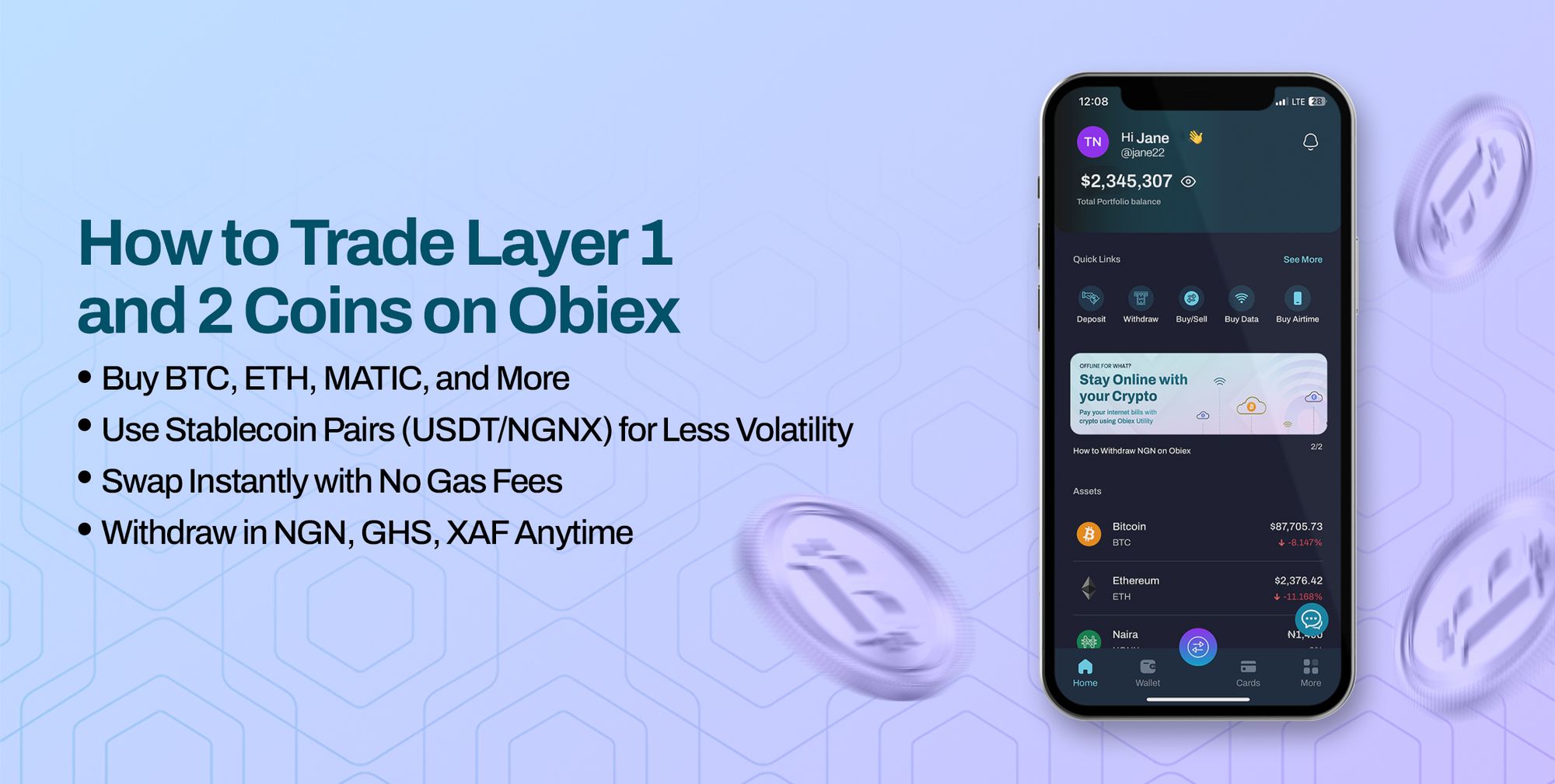
To Recap
To sum it up:
- Layer 1 = the foundation of crypto networks. Strong and secure, but can be slow and pricey.
- Layer 2 = the upgrade that enables faster and cheaper crypto usage without compromising security.
- Layer 1 coins are better for long-term holding and secure base-layer development.
- Layer 2 coins are better for quick trades, daily payments, and cost-effective DeFi use.
- Using both layers allows traders to balance security and speed while managing risk.
With Obiex, you don’t have to choose between speed and security. You can get both.
👉Start trading smarter.
Buy, swap, and send both Layer 1 and Layer 2 coins on Obiex with zero gas fees and full local currency support.
FAQs
Q1. What are Layer 1 coins?
These are the main blockchain networks like Bitcoin, Ethereum, and Solana. They handle security, transactions, and decentralisation.
Q2. What are Layer 2 coins?
Layer 2 coins are built on top of Layer 1 networks to make transactions faster and cheaper. Examples include Polygon, Arbitrum, and Lightning Network.
Q3. Is Ethereum a Layer 1 or Layer 2 coin?
Ethereum (ETH) is a Layer 1 coin. Polygon and Arbitrum are Layer 2 solutions built on top of it.
Q4. Why are Layer 2 coins cheaper to use?
Because they process transactions off-chain and batch them onto Layer 1 later, reducing congestion and fees.
Q5. Can I buy Layer 2 crypto in Nigeria?
Yes, with Obiex, you can buy and trade Layer 2 coins like MATIC, ARB, and OP in Nigeria.
Q6. How do I swap Layer 1 to Layer 2 on Obiex?
Use the crypto swap feature on Obiex to instantly convert between assets like ETH and MATIC — no gas fees involved.
Q7. Is Bitcoin on the Lightning Network still Bitcoin?
Yes, it’s still BTC. The Lightning Network just makes it faster and cheaper to send.
Q8. Which is better: Layer 1 or Layer 2?
Neither is “better”. They serve different purposes. Use Layer 1 for security and long-term storage; Layer 2 for speed and transactions.
Q9. What is the crypto Layer 2 meaning in simple terms?
It means a faster, cheaper system built on top of a bigger, slower blockchain.
Q10. Does Obiex support both Layer 1 and Layer 2 coins?
Absolutely. You can trade Obiex Layer 1 and Layer 2 coins with ease, without paying any gas fees.
Disclaimer: This article was written to provide guidance and understanding. It is not an exhaustive article and should not be taken as financial advice. Obiex will not be held liable for your investment decisions.
